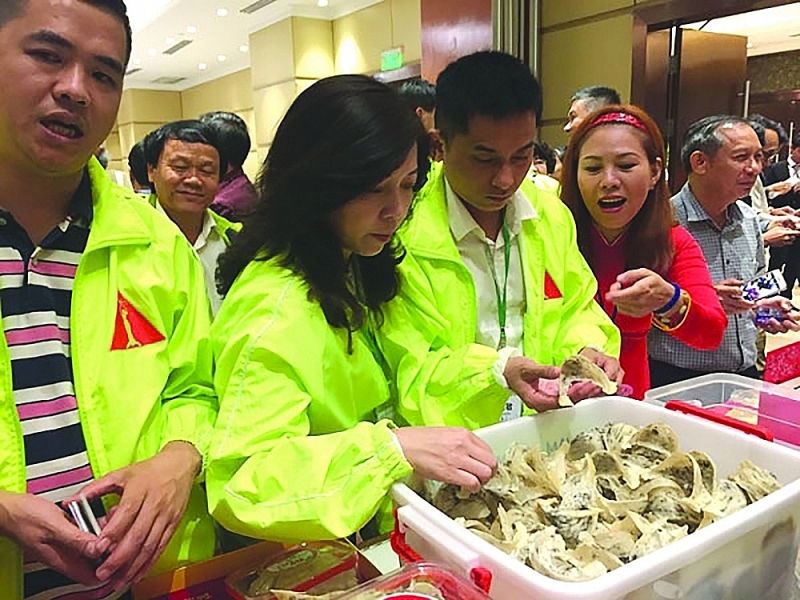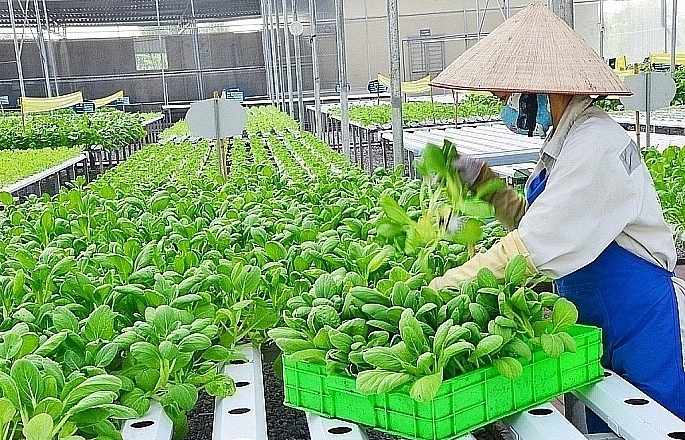Taking the initiative in the face of changes in the Chinese market
 |
| Chinese enterprises learn about Vietnam's bird's nest products. Photo: N.H |
Advice from the Chinese market
With 15 years of experience in building Vietnamese brands in the Chinese market, Dr. Tra My, President of the temporary Association of Vietnamese Enterprises in China, has given useful advice to Vietnamese enterprises.
Accordingly, before bringing Vietnamese agricultural products to this market of 1.4 billion people, enterprises should protect their brands. Next, Vietnamese enterprises should find importers or distributors with economic potential, good sales channels, and a team dedicated to developing the brand of Vietnamese agricultural products.
In particular, Vietnamese enterprises should take advantage of overseas Vietnamese or Vietnamese business associations in local countries.
| Enterprises that have been granted export codes in 2021 need to supplement information to register for export to China under Order 248 before June 30, 2023 according to Notice No. 2359/BVTV-ATTPMT dated August 11, 2022 posted on the website of the Plant Protection Department. Units registering for issuance of new export codes or additional information in 2021 must follow the instructions at No. 953/BVTV-ATTPMT dated April 13, 2022, posted on the website of the Plant Protection Department. |
Dr. Tra My also noted that Vietnamese enterprises should “do as the Romans does when in Rome”. China is a country with very high requirements for designs, the quantity was not much, but the gift box must be beautiful.
Therefore, Vietnam should focus on design and especially pay attention to even numbers, so it was 2, 6 and 8. Besides, if one enterprise wanted to do long-term business, it should open a representative office or open a subsidiary in China.
Dr. Tra My also added that, currently, the temporary Vietnamese Enterprise Association in China was providing free support for Vietnamese enterprises to protect their brands and logos before entering the Chinese market. The association also supports the exhibition space for Vietnamese agricultural product brands that were eligible to export to the Chinese market at the Vietnam National Pavilion in China. For provinces with large sources of agricultural products, the Association was ready to participate in offers with the largest importers in China.
Meanwhile, from the side of Chinese enterprises, Mr. Bob Wang, Chairman of Nanning Enterprise Association, Guangxi province, China, assessed that many Vietnamese fruit producers lacked an understanding of Chinese market trends and sold passively without understanding the real demand of the market. “When China's wholesale markets open in the morning, Thai traders are usually able to capture prices very quickly and sell products efficiently, while Vietnamese traders are slower. Therefore, Vietnam needs to build a model of close connection between producers and sellers to be able to grasp information about the Chinese market quickly," Mr. Bob Wang recommended.
Mr. Bob Wang also suggested that Vietnam set up a trade promotion agency for agricultural products with China to help the development of brands and marketing of Vietnamese agricultural products in China. “Whether it's setting up a permanent office in China or through online shopping, it provides Chinese buyers with more convenient shopping channels with fewer middlemen,” said Bob Wang.
Ready for any new requirements on quality standards
Ms. Nguyen Thi Phuong Hoa, representative of the Plant Protection Bureau, Ministry of Agriculture and Rural Development (MARD), emphasized that China's requirements on food safety for imported products were increasingly strict and continuously updated and supplemented.
Accordingly, foreign enterprises producing food for China need to meet Article 5 of Order 248, including belonging to a country with a food safety management system assessed by the General Administration of Customs of China (GACC); established and subject to the effective supervision of the competent national authority; establishing an effective and legal food safety management system in production and export in that country and ensuring that food exported to China meets relevant laws, regulations and China's food safety standards.
Regarding the management of planting areas, MSc. Ngo Xuan Chinh, Director of the Center for Research and Transfer of Agricultural Technology Advancement, Southern Institute of Agricultural Science and Technology, said that the establishment of planting area management according to VietGAP standards would ensure transparency to trace the origin of products and improve the quality and efficiency of Vietnam's agricultural production.
MSc. Ngo Xuan Chinh noted that organizations and individuals producing according to VietGAP standards must organize an internal inspection according to the requirements of VietGAP once every 12 months. When non-conformities are detected, the cause must be analyzed and corrective actions must be made. Time to take corrective action before delivery to the customer but not more than 3 months depending on the content of the point of non-conformity. For a multi-member production facility and a facility with multiple production sites, all members and production locations must be inspected. Inspection results and corrective action for points inconsistent with VietGAP must be documented and recorded.
For bird's nest products, Mr. Do Van Hoan, Deputy Head of Animal Breeding Division, Bureau of Livestock Production, said that the official export of bird's nests to China was mentioned in the protocol dated November 9, 2022 between the Ministry of Agriculture and Rural Development and the General Administration of Customs of China.
The exporters must be registered with the competent authority in Vietnam and dossiers must be approved by the General Administration of Customs of China. The system of state management documents had many decrees, regulations and circulars detailing requirements on regulations on breeding houses, preliminary processing conditions, and quality of bird's nest.
According to Mr. Do Van Hoan, the Bureau of Livestock Production coordinated with VNPT Group to build software to update the database of livestock and feed establishments. Thus, in addition to normal registration, establishments could also register online.
In order to be transparent about specific information about the crop, Mr. Le Thanh Hoa, Director of SPS Vietnam Office, suggested that localities should strengthen close coordination with the Plant Protection Bureau. “Each region, each locality from Dak Lak, Dak Nong to Tien Giang and Ben Tre needs to be transparent about the time and output of each crop to provide information. From there, the Plant Protection Bureau, as well as the General Administration of Customs of China, could monitor and carry out the export of agricultural products in accordance with the process and code,” Mr. Hoa emphasized.
Mr. Le Thanh Hoa also noted that if not strictly implemented, it was entirely possible that the Chinese side would halt imports, thereby affecting the reputation of Vietnam's agricultural products.
In the near future, the agencies of the Ministry of Agriculture and Rural Development will coordinate to develop good practice procedures for each type of fruit to ensure the export as well as the requirements of the Chinese side, in case the Chinese General Customs Department has strengthened the inspection of microbiological contamination as well as chemical residues, Vietnamese agricultural products can still meet.
Related News

Hanoi: Maximum support for affiliating production and sustainable consumption of agricultural products
09:43 | 25/12/2024 Import-Export

Promoting agricultural exports to the Japanese market
13:55 | 22/12/2024 Import-Export
Latest News

VN seafood export surpass 2024 goal of $10 billion
14:59 | 25/12/2024 Import-Export

Exporters urged to actively prepare for trade defence investigation risks when exporting to the UK
14:57 | 25/12/2024 Import-Export

Electronic imports exceed $100 billion
14:55 | 25/12/2024 Import-Export

Forestry exports set a record of $17.3 billion
14:49 | 25/12/2024 Import-Export
More News

Việt Nam boosts supporting industries with development programmes
13:56 | 24/12/2024 Import-Export

VN's wood industry sees chances and challenges from US new trade policies
13:54 | 24/12/2024 Import-Export

Vietnam's fruit, vegetable exports reach new milestone, topping 7 billion USD
13:49 | 24/12/2024 Import-Export

Aquatic exports hit 10 billion USD
13:45 | 24/12/2024 Import-Export

Hong Kong: A gateway for Vietnamese businesses to access the Greater Bay Area market
09:04 | 24/12/2024 Import-Export

UK a niche market for Vietnamese speciality coffee
14:11 | 23/12/2024 Import-Export

Vietnam-US trade thrives on effective mechanisms: trade counsellor
14:08 | 23/12/2024 Import-Export

Opening of overseas markets boosts coconut exports
13:59 | 23/12/2024 Import-Export

Increasing consumption demand, steel enterprises face many opportunities
11:08 | 23/12/2024 Import-Export
Your care

VN seafood export surpass 2024 goal of $10 billion
14:59 | 25/12/2024 Import-Export

Exporters urged to actively prepare for trade defence investigation risks when exporting to the UK
14:57 | 25/12/2024 Import-Export

Electronic imports exceed $100 billion
14:55 | 25/12/2024 Import-Export

Forestry exports set a record of $17.3 billion
14:49 | 25/12/2024 Import-Export

Hanoi: Maximum support for affiliating production and sustainable consumption of agricultural products
09:43 | 25/12/2024 Import-Export





